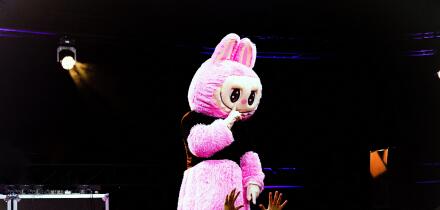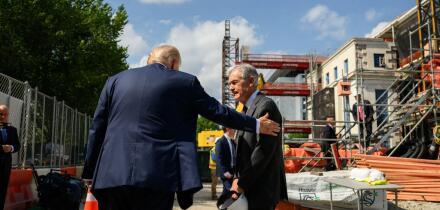The interest-rate implied volatility surface exhibits a maturity and smile or skew (strike dependent) structure. This observation means that the interest rate market does not follow the Black-Scholes model.
The introduction of one-factor interest rate models improves the situation greatly, and these models form the bulk of the models used in the market place. These one-factor no-arbitrage interest rate models assume that the short rate,rt , follows the stochastic differential equation
with drift µ(r t, t), local volatility *(r t, t), and where dWt is a Gaussian process. Specific examples of these include extended Vasicek (a normal-type model), extended Cox-Ingersoll-Ross and
which is the process for the Black-Karasinski (a lognormal-type) model. All these models are mean reverting and fit the initial forward rate curve. These models provide a single framework for valuing vanilla and complex products.
The model, in particular the diffusion parameter *(r t, t), then has to then be calibrated to the liquid interest rate options quoted in the market. These usually are usually at-the-money vanilla instruments, options on Eurodollar futures, caps and floors, and European swaptions. These are chosen because they are the most liquidly traded options available and because the models have only one degree of freedom for each maturity. These models therefore provide a single framework within which to value vanilla and complex products.
What about the smile, though? Through the calibration, these models fit the term structure of at-the-money implied volatilities, but they have an explicit skew, dependent on the model which inevitabley is not the observed market skew. This can be seen clearly in the figure at right. There is no flexibility to easily adjust the skew or smile surfaces.
Capturing skews and smiles
An increasingly important area in interest rate modelling is not only the ability to not only capture the at-the-money volatilities but also the provide the flexibility to match the market volatility skew and smile. This is not necessary for pricing the majority of interest rate derivatives; however, there are cases where the impact of different skew/smiles surfaces will affect the prices considerably. Such instruments include, in general, path-dependent instruments, as well as volatility bonds and digital caps. As a general rule, these skew models are important if the instrument's natural hedge includes non- at-the-money options.
Volatility skew implied by standard one-factor models
Models capable of capturing the market skew and smile have
been studied in great detail for equity index products, where the underlying is much simpler. However, the situation is not as simple for interest rates, where, for each point in time, there is a whole term structure of interest rates, and where the market observed quantities (LIBOR, swap rates and bond prices) are obtained by compounding the short rate.
However, using a parametric mapping from a Gaussian will allow us to build a modelling framework to meet all these requirements. A general approach when implementing a one-factor model is to first build a tree/lattice solution for a simple Gaussian process, xt ,
and then construct the process for the short rate defined through a parametric mapping from the Gaussian space, given by rt = f(t, xt). For example, the mapping to a lognormal can be achieved using rt =ro exp(x t). Introducing non-standard mappings allows one to construct one-factor models with extra degrees of freedom that enable the model to capture the market skew and smile effects.
Consider a skewed volatility surface, where the implied volatility shape is somewhere between the skews predicted by the Vasicek and Black-Karasinski models (i.e. somewhere between normal and lognormal). Given this observation, a skewed model can easily be constructed easily if we interpolate the volatility term *(r t, t) between the normal and lognormal. For example, an exponent interpolation rt * gives the CEV model while where as a linear interpolation *r t + (1-*) gives the offset lognormal model (also known as the q-distribution). In both cases, * *0 gives the normal model and * * 1 gives the lognormal model. Both models provide a parameterization of the skew through *.
More complex transformations can be made to allow the capture for of kurtosis (the smile effect) and thereby provide another parameter that controls degree of kurtosis. The figure below provides examples of parameterised skewed and smile implied volatilities.
Skew adjusted (dotted line) and kurtotic adjusted (solid line) model results
The mapping parameters that control the degree of skew or kurtosis prove to be very useful for risk control and management purposes. They allow the measurement of a portfolio's exposure to moves in the market skew or smile, and if required, can be hedged or at least controlled.
The models detailed here are only one of the possible classes of models capable of capturing the market smile and skew. Alternatives include stochastic volatility and jump diffusion models. The model approach here is generally regarded as being preferred because it is designed to fit the smile surface, is risk-preference free, is computationally efficient, and does not introduce additional stochastic factors that are difficult to estimate from market data. The other models do not meet these standards.
However, for some products, these models will still not be able to capture some of the risks to which they are exposed. This is particularly important for products that are sensitive either to higher order yield curve movements (for example spread options) or to the volatility of volatility (for example options on an option). The approach given here can easily be extended to multiple factors and stochastic volatility; however, this will be at the expense of computational efficiency.
Conclusion
Current market standard models have limitations in capturing the market-observed implied volatility smile. But here is a modelling framework that overcomes these limitations.
This week's Learning Curve was written by Douglas Long, European head of quantitative research and development at Principia Partnersin London.






